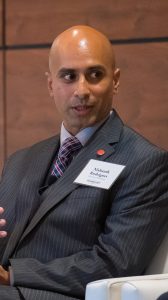
Employees in the UM Office of Information Technology have worked since earlier this year to ensure that university systems continue to operate while on-campus operations are suspended for the COVID-19 pandemic. This ensures that the university can continue to provide students and faculty with opportunities to excel. Photo courtesy Gorodenkoff Productions OU
OXFORD, Miss. – When the decision was made, no switch was flipped or button pressed.
After an extended spring break packed with round-the-clock planning and discussion, the University of Mississippi switched from in-person to remote methods of learning and teaching on March 23 in response to the COVID-19 pandemic.
By the end of that first Monday of remote classes, more than 15,500 Ole Miss students had interacted with some 3,200 courses in Blackboard, the university’s online learning management system. The myOleMiss portal saw 7,500 unique students log in over a single day.
The increased online activity was roughly double the normal load, though below what the university typically experiences during finals. Elsewhere, the university’s virtual private network saw an increase in users, as did its online business operations and customer relations software, as more faculty and staff logged in to work remotely.
Throughout that first week, a few hiccups and challenges occurred, and those have continued. The adjustment hasn’t been perfect as students, faculty and staff have experienced individual difficulties. But since adapting to the COVID-19 outbreak, the university has strived to fulfill its mission of educating students and transforming lives, communities and the world.
“Our first priority was safety; after that, we were focused on how to help our students finish the semester and keep our mission-critical activities functioning in a remote environment,” Provost Noel Wilkin said.
Thousands of people – from UM students, faculty and staff spread out around the world to Ole Miss alumni, donors and friends – have come together to ensure the university has continued providing opportunities for the people of Mississippi and beyond.
Hundreds of employees have worked tirelessly – in the middle of the night and on weekends – so that the university can continue to provide students and faculty with opportunities to excel.
But behind the firewalls and virtual private network servers, the Zoom sessions, the myOleMiss campus portal, the bursar account statements and the payroll systems is the UM Office of Information Technology, a group of about 90 full-time and 20 student employees who silently make sure the university still hums.
“IT and the people who manage our systems were critical to our success in making the shift,” Wilkin said. “They simply figured out how to make it work and did it.

Nishanth Rodrigues, UM chief information officer and chief information security officer, answers a question during an on-campus event. Photo by Kevin Bain/Ole Miss Digital Imaging Services
The group is “an amazing team,” said Nishanth Rodrigues, the university’s chief information officer and chief information security officer.
“They have demonstrated their ability to deliver in this extraordinary, high-pressure situation,” he said. “The diligence and dedication demonstrated by each of them is nothing short of outstanding.
“This is what they do every day. The difference is that in this situation, their efforts and results are highly visible. They’ve kept their other projects going and their operational duties on schedule while managing this transition to remote teaching and learning. It didn’t faze them one bit.”
Steps to Going Online, Remote
As the coronavirus started spreading around the globe earlier this year, with the first case in the U.S. being identified Jan. 20 in Washington, UM officials began discussions about how to confront the emerging health crisis.
UM first updated the university community on the virus on Jan. 27, and by the end of February had created a COVID-19 Update Page as officials continued talks about what impact the virus might have on the university.
Those discussions led to the organization of the Academic Continuity Contingency Task Force on March 4. At its first meeting, the task force worked to understand what it would take to move UM to remote learning and teaching and began drawing up a plan.
“As you can imagine, much of where we are today was unexpected and unprecedented as recently as the beginning of March,” Rodrigues said. “What was in front of us seemed quite daunting, considering the numerous projects and operational workload we already had on our plates, but we were quick to develop a clear plan for our institution.”
Before the task force was formed – and even before the emergence of COVID-19 – the university’s IT office had already made business decisions that would help it manage this crisis.
“IT has always focused on automation in an attempt to reduce overhead and allow faculty and staff to focus on more meaningful use of their talents,” said Chris Reichley, director of application development and integration. “UM IT is a ‘roll-up-our-sleeves’ culture.
“The high level of technical expertise and ability in the IT staff means we can create and adapt our processes and services quickly without the time and expense required to bring in consultants for specialized tasks.”
The department had long planned for the worst and hoped for the best, and that motto served it well for this transition. The university also recently completed a network upgrade that positioned its infrastructure to withstand the transition.
On March 6, the same day that the University of Washington became the first major university to cancel in-person classes amid virus concerns, UM faculty were asked to plan for shifting to remote learning and teaching if needed. Six days later, UM announced all classes on the Oxford and regional campuses were canceled for March 16-20, essentially extending spring break by one week.
That week was used to finalize the transition from in-class to remote methods of learning and teaching.
“Right from the start, since this is so new for our institution, there were many unknowns,” Rodrigues said. “IT departments rely on data to develop our plans. In the absence of this data, we developed several contingency plans for different scenarios.
“Ultimately, all of those plans hinged on the fighting spirit of the individual faculty, staff and students who make up the University of Mississippi.”

Powers Hall is home to the UM Office of Information Technology. Photo by Robert Jordan/Ole Miss Digital Imaging Services
Still, questions remained.
What would happen to students and faculty who lacked sufficient internet connectivity for remote learning and teaching? Could Zoom, the university’s primary videoconferencing vendor, handle the enormous increase in worldwide demand for its services caused by the pandemic? How would staff and faculty transition to remote work and communicating from home?
“We are a team of ‘can-do’ individuals,” Rodrigues said. “We prioritized our work activities to achieve the proposed objectives.
“Usually, we prefer to be more deliberate in making big changes such as this. We are in different times that called for different measures.”
On March 19, the university announced that it would “deliver all course content online or via other remote methods for the remainder of the Spring 2020 semester.”
“The transition from a mostly in-person institution to an all-remote one in the span of fewer than two weeks was made possible by smart leadership from key players around the university, along with the intelligent application of familiar technologies at an unprecedented – for UM – scale and a truly extraordinary amount of very hard work carried out by the individual professionals in the offices of Academic Computing, Academic Outreach, the Academic Innovations Group and others,” said Brian Hopkins, deputy chief information officer for academic technology.
As learning and teaching moved to remote methods, there also was concern about how to keep remote workers communicating from home.
“We had been preparing for a significant upgrade to the phone system, which was slated for December 2020,” said Michele Patton, director of telecommunications. “Instead, we accelerated our implementation to take place on March 20 and rolled out the Avaya IX Workplace app to allow people to work remotely easier.
“We have also leveraged other features, such as call forwarding, an extension-to-cell-phones setup and voicemail to assist with this effort.”
A month in, the university’s technology is “holding strong,” said David Drewrey, UM deputy chief information officer and director of technical services.
“The rapid shift to online teaching and learning did make it tough on our faculty, staff and students,” Hopkins said. “In many cases, it turned out that the technology questions were easier to solve as compared to the process questions that came our way.
“The biggest challenge has been the continuing changes in the staffing model of the university, with alterations in university policy regarding work-from-home rules. It took a herculean effort from telecommunications and preparations by our technical services group to get all of our constituents working from home.”
Going Forward
Almost all the critical objectives of moving the university to remote methods have been realized. During that first week, 91 percent of Ole Miss students interacted with at least one Blackboard class. Faculty hosted more than 400 Zoom meetings, including more than 5,000 participants and covering more than 150,000 meeting-minutes each day.
“In support of the educational mission of the university, the university’s normal business operations have functioned efficiently,” said Al Ling, director of business applications and enterprise resource planning support. “IT has maintained its usual level of support for the technical systems that pay bills; deliver payroll for faculty, staff and students; adjust student accounting to not charge service fees on unpaid balances; and more.
“All this is accomplished while everyone – both functional and technical – were scattered, working remotely.”
With such a swift and unexpected move to a new mode of learning and teaching, service gaps remain that need to be remedied.
One obstacle is testing. The load on Blackboard is always highest during final exams, so the IT office worked with many other campus offices on strategies to reduce this load.
Also, with computer labs no longer physically accessible to students, IT is working to identify a method for students to remotely access lab resources through either public or private cloud computing.
Finally, there is the intense workload IT has already faced and will continue to face in coming weeks. Employees are working long hours, some outside their areas of expertise. Some are even still willingly coming to campus.
Amid a pandemic and a sudden switch in the university’s learning, teaching and operational methods, the IT staff have handled the work with skill and professionalism, Rodrigues said.
“They’ve aspired to a level of excellence,” he said. “They always find a way to get it done – and done well. Taking on additional responsibilities that help the university achieve its objectives is typical of our IT team. I am honored to be a member of such a great group.”